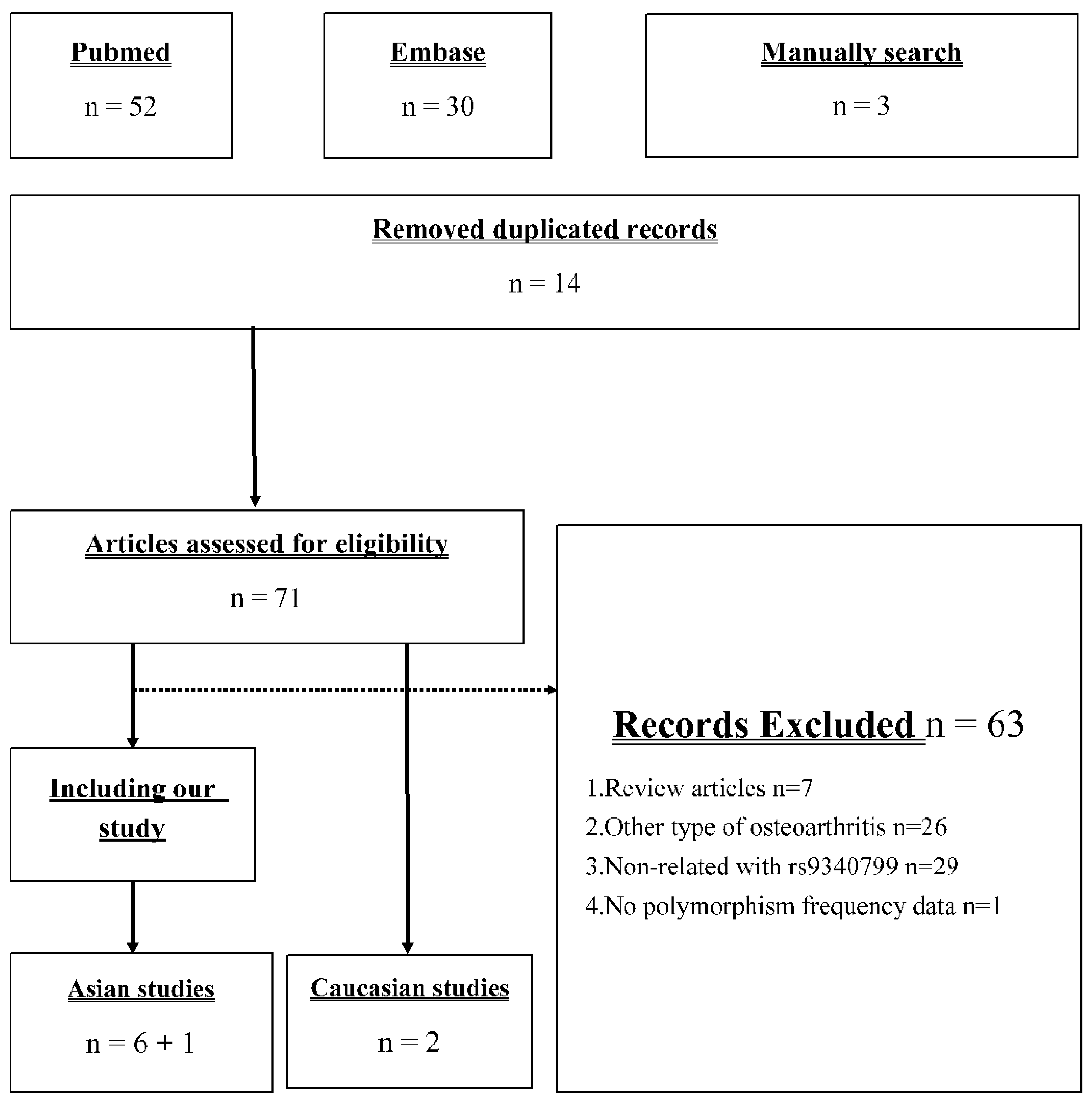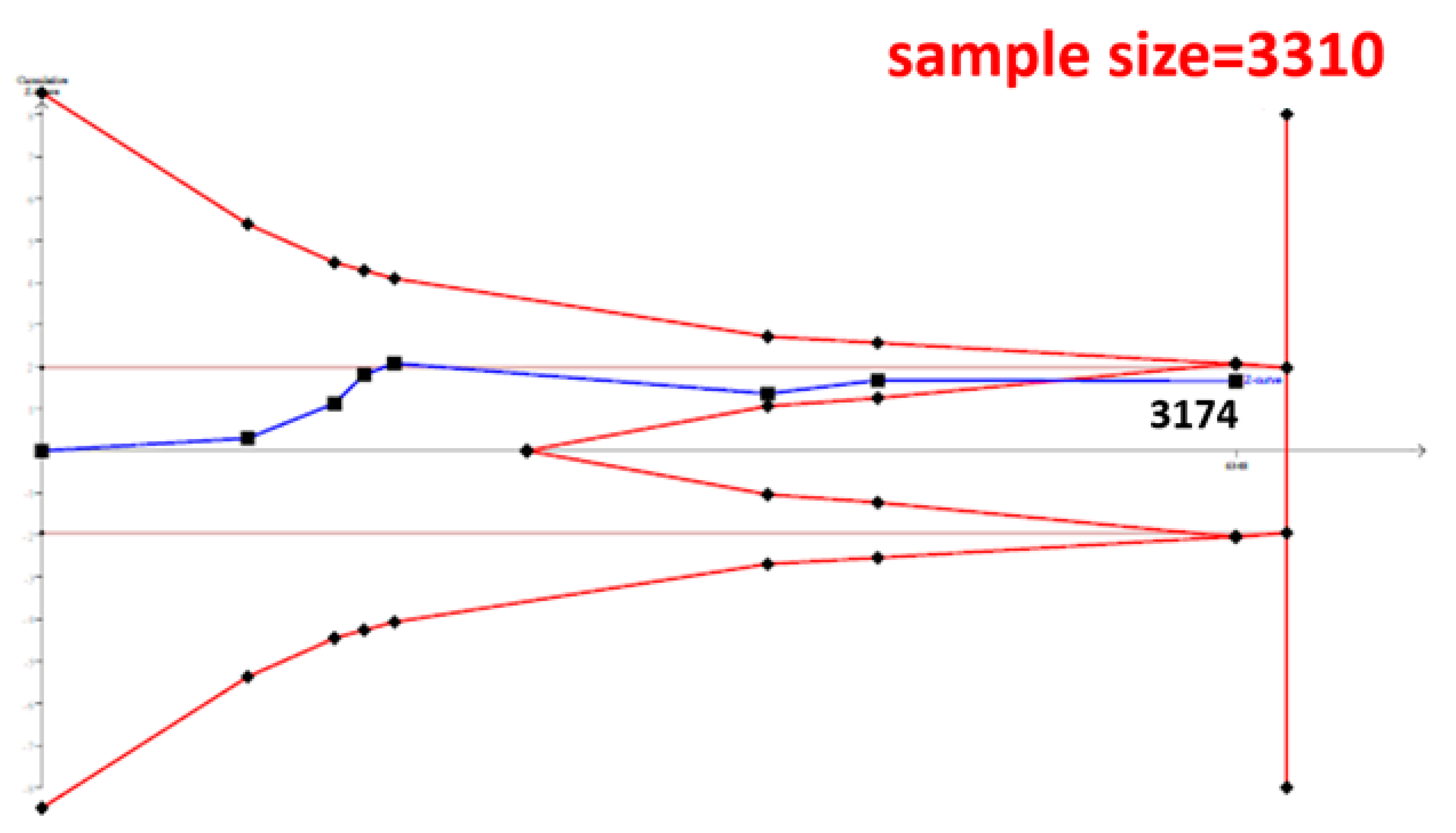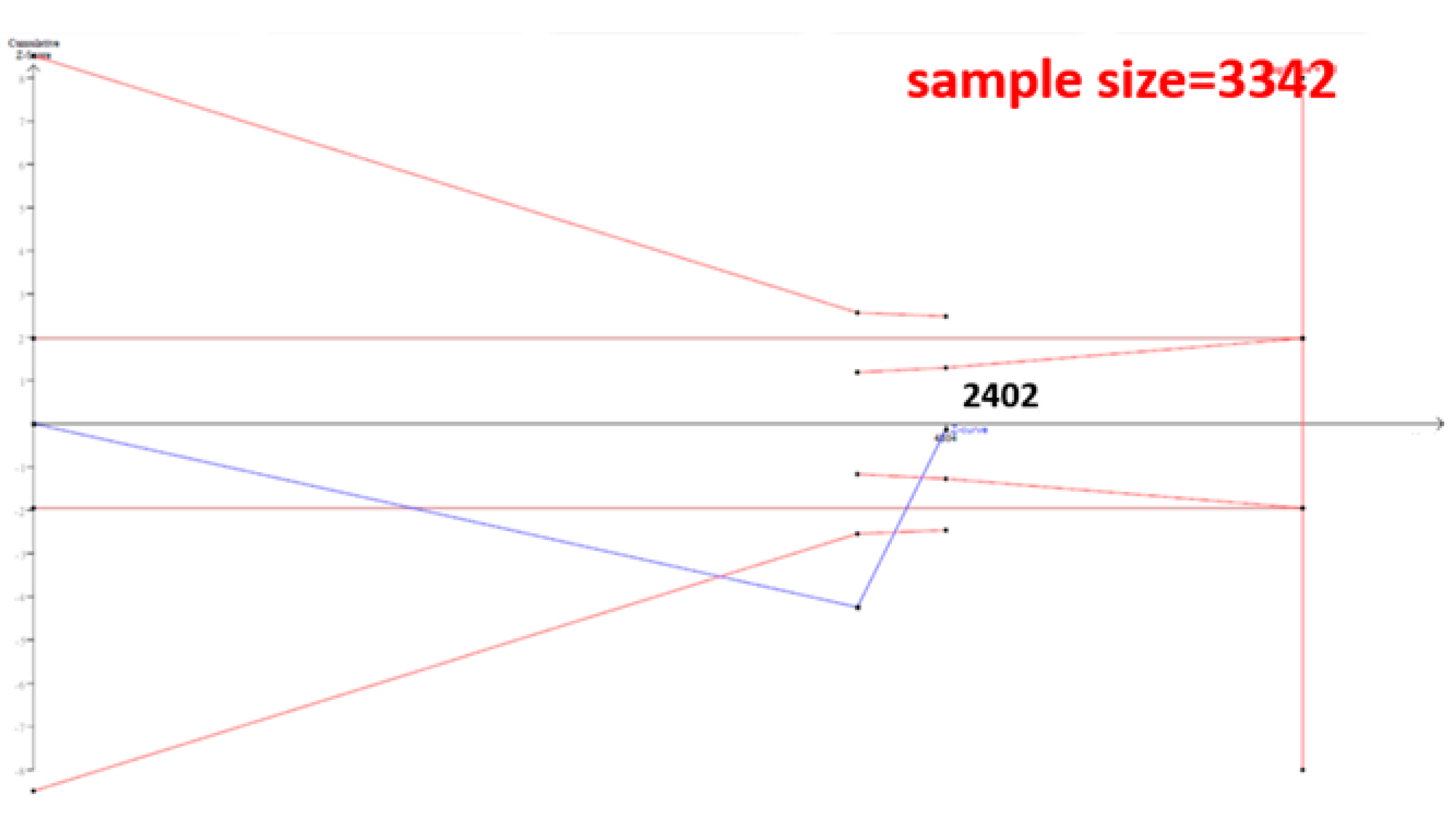The Decisive Case-Control Study Elaborates the Null Association between ESR1 XbaI and Osteoarthritis in Asians: A Case–Control Study and Meta-Analysis
Abstract
1. Introduction
2. Materials and Methods
2.1. Case–Control Study
2.1.1. Sample Size and Ethical Issues
2.1.2. Subjects
2.1.3. Genomic DNA Extraction and Genotyping
2.1.4. Statistical Analysis
2.2. Meta-Analysis
2.2.1. Search Methods and Criteria for Study Consideration
2.2.2. Data Extraction and Quality Assessment
2.2.3. Statistical Analysis
3. Results
3.1. Case–Control Study
3.2. Meta-Analysis
3.3. TSA Evaluation
4. Discussion
Supplementary Materials
Author Contributions
Funding
Institutional Review Board Statement
Informed Consent Statement
Conflicts of Interest
References
- Felson, D.T.; Lawrence, R.C.; Dieppe, P.A.; Hirsch, R.; Helmick, C.G.; Jordan, J.M.; Kington, R.S.; Lane, N.E.; Nevitt, M.C.; Zhang, Y.; et al. Osteoarthritis: New Insights. Part 1: The Disease and Its Risk Factors. Ann. Intern. Med. 2000, 133, 635–646. [Google Scholar] [CrossRef]
- Piva, S.R.; Susko, A.M.; Khoja, S.S.; Josbeno, D.A.; Fitzgerald, G.K.; Toledo, F.G. Links Between Osteoarthritis and Diabetes. Clin. Geriatr. Med. 2015, 31, 67–87. [Google Scholar] [CrossRef]
- Lin, F.-H.; Chen, H.-C.; Lin, C.; Chiu, Y.-L.; Lee, H.-S.; Chang, H.; Huang, G.-S.; Chang, H.-L.; Yeh, S.-J.; Su, W.; et al. The increase in total knee replacement surgery in Taiwan. Medicine 2018, 97, e11749. [Google Scholar] [CrossRef] [PubMed]
- Fransen, M.; Bridgett, L.; March, L.; Hoy, D.; Penserga, E.; Brooks, P. The epidemiology of osteoarthritis in Asia. Int. J. Rheum. Dis. 2011, 14, 113–121. [Google Scholar] [CrossRef] [PubMed]
- MacGregor, A.J. Twins and the genetic architecture of osteoarthritis. Rheumatology 1999, 38, 583–588. [Google Scholar] [CrossRef] [PubMed]
- Valdes, A.M.; Van Oene, M.; Hart, D.J.; Surdulescu, G.L.; Loughlin, J.; Doherty, M.; Spector, T.D. Reproducible genetic associations between candidate genes and clinical knee osteoarthritis in men and women. Arthritis Rheum. 2006, 54, 533–539. [Google Scholar] [CrossRef] [PubMed]
- Reginato, A.M.; Olsen, B.R. The role of structural genes in the pathogenesis of osteoarthritic disorders. Arthritis Res. 2002, 4, 337–345. [Google Scholar] [CrossRef]
- Snelling, S.; Sinsheimer, J.S.; Carr, A.; Loughlin, J. Genetic association analysis of LRCH1 as an osteoarthritis susceptibility locus. Rheumatology 2006, 46, 250–252. [Google Scholar] [CrossRef] [PubMed][Green Version]
- Evangelou, E.; Chapman, K.; Meulenbelt, I.; Karassa, F.B.; Loughlin, J.; Carr, A.; Doherty, M.; Doherty, S.; Gomez-Reino, J.J.; González, A.; et al. Large-scale analysis of association betweenGDF5andFRZBvariants and osteoarthritis of the hip, knee, and hand. Arthritis Rheum. 2009, 60, 1710–1721. [Google Scholar] [CrossRef]
- Boyan, B.D.; Tosi, L.L.; Coutts, R.D.; Enoka, R.M.; A Hart, D.; Nicolella, D.P.; Berkley, K.J.; A Sluka, K.; Kwoh, C.K.; I O’Connor, M.; et al. Addressing the gaps: Sex differences in osteoarthritis of the knee. Biol. Sex Differ. 2013, 4, 4. [Google Scholar] [CrossRef]
- Phinyomark, A.; Osis, S.T.; Hettinga, B.A.; Kobsar, D.; Ferber, R. Gender differences in gait kinematics for patients with knee osteoarthritis. BMC Musculoskelet. Disord. 2016, 17, 157. [Google Scholar] [CrossRef] [PubMed]
- Woolf, A.D.; Pfleger, B. Burden of major musculoskeletal conditions. Bull. World Health Organ. 2003, 81, 646–656. [Google Scholar]
- Kolhe, R.; Hunter, M.; Liu, S.; Jadeja, R.N.; Pundkar, C.; Mondal, A.K.; Mendhe, B.; Drewry, M.; Rojiani, M.V.; Liu, Y.; et al. Gender-specific differential expression of exosomal miRNA in synovial fluid of patients with osteoarthritis. Sci. Rep. 2017, 7, 2029. [Google Scholar] [CrossRef]
- Cheung, E.; Schwabish, M.A.; Kraus, W. Chromatin exposes intrinsic differences in the transcriptional activities of estrogen receptors α and β. EMBO J. 2003, 22, 600–611. [Google Scholar] [CrossRef][Green Version]
- Alcazar, L.P.; Arakaki, P.A.; Godoy-Santos, A.; Santos, M. Estrogen Receptor Polymorphism and Its Relationship to Pathological Process. Am. J. Med. Sci. 2010, 340, 128–132. [Google Scholar] [CrossRef] [PubMed]
- Ma, H.; Wu, W.; Yang, X.; Liu, J.; Gong, Y. Genetic effects of common polymorphisms in estrogen receptor α gene on osteoarthritis: A meta-analysis. Int. J. Clin. Exp. Med. 2015, 8, 13446–13454. [Google Scholar]
- Ren, Y.; Tan, B.; Yan, P.; You, Y.; Wu, Y.; Wang, Y. Association between polymorphisms in the estrogen receptor α gene and osteoarthritis susceptibility: A meta-analysis. BMC Musculoskelet. Disord. 2015, 16, 44. [Google Scholar] [CrossRef]
- Yazdi, M.M.; Jamalaldini, M.H.; Sobhan, M.R.; Jafari, M.; Mazaheri, M.; Zare-Shehneh, M.; Neamatzadeh, H. Association of ESRα Gene Pvu II T>C, XbaI A>G and BtgI G>A Polymorphisms with Knee Osteoarthritis Susceptibility: A Systematic Review and Meta-Analysis Based on 22 Case-Control Studies. Arch. Bone Jt. Surg. 2017, 5, 351–362. [Google Scholar]
- Liu, W.; Shao, F.-M.; Yan, L.; Cao, H.-X.; Qiu, D. Polymorphisms in the gene encoding estrogen receptor α are associated with osteoarthritis in Han Chinese women. Int. J. Clin. Exp. Med. 2014, 7, 5772–5777. [Google Scholar]
- Dai, X.; Wang, C.; Dai, J.; Shi, D.; Xu, Z.; Chen, D.; Teng, H.; Jiang, Q. Association of Single Nucleotide Polymorphisms in Estrogen Receptor α Gene with Susceptibility to Knee Osteoarthritis: A Case-Control Study in a Chinese Han Population. BioMed Res. Int. 2014, 2014, 151457. [Google Scholar] [CrossRef] [PubMed]
- Borgonio-Cuadra, V.M.; González-Huerta, C.; Duarte-Salazar, C.; de los Ángeles Soria-Bastida, M.; Cortés-González, S.; Miranda-Duarte, A. Analysis of estrogen receptor α gene haplotype in Mexican mestizo patients with primary osteoarthritis of the knee. Rheumatol. Int. 2011, 32, 1425–1430. [Google Scholar] [CrossRef] [PubMed]
- Yang, J.; Fu, S.; Xiao, F. Case-control study between estrogen receptor gene polymorphisms and osteoarthritis in southern Sichuan high fluoride areas. West China Med. J. 2009, 24, 26–29. [Google Scholar]
- Tian, Z.; Guo, X.-F.; Zhou, F.; Huang, C.; Su, M.; Long, X. Study on Relationship Between Polymorphisms of Estrogenα Receptor Gene and Primary Knee Osteoarthritis Among Women in Hunan. Pract. Prev. Med. 2009, 6, 1724–1727. [Google Scholar]
- Xue, Y. Relationship between estrogen receptor gene polymorphism and osteoarthritis in Han ethnicity women. Osteoporos Bone Miner Res. 2004, 3, 6–10. [Google Scholar]
- Jin, S.-Y.; Hong, S.-J.; Yang, H.I.; Park, S.-D.; Yoo, M.-C.; Lee, H.J.; Hong, M.-S.; Park, H.-J.; Yoon, S.H.; Kim, B.-S.; et al. Estrogen receptor-α gene haplotype is associated with primary knee osteoarthritis in Korean population. Arthritis Res. Ther. 2004, 6, R415–R421. [Google Scholar] [CrossRef]
- Bergink, A.P.; Van Meurs, J.B.; Loughlin, J.; Arp, P.P.; Fang, Y.; Hofman, A.; Van Leeuwen, J.P.T.M.; Van Duijn, C.M.; Pols, H.A.P. Estrogen receptor ? gene haplotype is associated with radiographic osteoarthritis of the knee in elderly men and women. Arthritis Rheum. 2003, 48, 1913–1922. [Google Scholar] [CrossRef]
- Brok, J.; Thorlund, K.; Gluud, C.; Wetterslev, J. Trial sequential analysis reveals insufficient information size and potentially false positive results in many meta-analyses. J. Clin. Epidemiol. 2008, 61, 763–769. [Google Scholar] [CrossRef]
- Kellgren, J.H.; Lawrence, J.S. Radiological Assessment of Rheumatoid Arthritis. Ann. Rheum. Dis. 1957, 16, 485–493. [Google Scholar] [CrossRef]
- Moher, D.; Liberati, A.; Tetzlaff, J.; Altman, D.G.; The PRISMA Group. Preferred reporting items for systematic reviews and meta-analyses: The PRISMA statement. PLoS Med. 2009, 6, e1000097. [Google Scholar] [CrossRef] [PubMed]
- Higgins, J.P.T.; Thompson, S.G.; Deeks, J.J.; Altman, D.G. Measuring inconsistency in meta-analyses. BMJ 2003, 327, 557–560. [Google Scholar] [CrossRef]
- Egger, M.; Smith, G.D.; Schneider, M.; Minder, C. Bias in meta-analysis detected by a simple, graphical test. BMJ 1997, 315, 629–634. [Google Scholar] [CrossRef]
- Martín-Millán, M.; Castañeda, S. Estrogens, osteoarthritis and inflammation. Jt. Bone Spine 2013, 80, 368–373. [Google Scholar] [CrossRef]
- Felson, D.T. The epidemiology of knee osteoarthritis: Results from the framingham osteoarthritis study. Semin. Arthritis Rheum. 1990, 20 (Suppl. 1), 42–50. [Google Scholar] [CrossRef]
- Nevitt, M.C.; Cummings, S.R.; Lane, N.E.; Hochberg, M.C.; Scott, J.C.; Pressman, A.R.; Genant, H.K.; Cauley, J.A. Association of estrogen replacement therapy with the risk of osteoarthritis of the hip in elderly white women. Study of Osteoporotic Fractures Research Group. Arch. Intern. Med. 1996, 156, 2073–2080. [Google Scholar] [CrossRef] [PubMed]
- Berenbaum, F. Osteoarthritis as an inflammatory disease (osteoarthritis is not osteoarthrosis!). Osteoarthr. Cartil. 2013, 21, 16–21. [Google Scholar] [CrossRef]
- Abel, K.; Reneland, R.; Kammerer, S.; Mah, S.; Hoyal, C.; Cantor, C.R.; Nelson, M.R.; Braun, A. Genome-wide SNP association: Identification of susceptibility alleles for osteoarthritis. Autoimmun. Rev. 2006, 5, 258–263. [Google Scholar] [CrossRef]
- Evangelou, E.; Valdes, A.M.; Kerkhof, H.J.M.; Styrkarsdottir, U.; Zhu, Y.; Meulenbelt, I.; Lories, R.J.; Karassa, F.B.; Tylzanowski, P.; Bos, S.D.; et al. Meta-analysis of genome-wide association studies confirms a susceptibility locus for knee osteoarthritis on chromosome 7q22. Ann. Rheum. Dis. 2010, 70, 349–355. [Google Scholar] [CrossRef]
- Lin, C.; Chu, C.-M.; Lin, J.; Yang, H.-Y.; Su, S.-L. Gene-Gene and Gene-Environment Interactions in Meta-Analysis of Genetic Association Studies. PLoS ONE 2015, 10, e0124967. [Google Scholar] [CrossRef] [PubMed]




| Case (N = 497) | Control (N = 473) | p Value | ||
|---|---|---|---|---|
| Gender | Female | 329 (66.2%) | 245 (51.8%) | <0.001 |
| Male | 168 (33.8%) | 228 (48.2%) | ||
| Age (years) | 75.07 ± 7.54 | 73.66 ± 7.41 | 0.003 | |
| Height (cm) | 157.77 ± 8.09 | 159.21 ± 7.90 | 0.008 | |
| Weight (kg) | 61.21 ± 11.49 | 61.24 ± 10.64 | 0.977 | |
| BMI (kg/m2) | 24.78 ± 3.64 | 24.12 ± 3.28 | 0.009 | |
| SBP (mmHg) | 132.79 ± 17.65 | 130.92 ± 16.04 | 0.131 | |
| DBP (mmHg) | 76.61 ± 10.20 | 77.08 ± 11.34 | 0.546 | |
| T-score | −0.51 ± 1.85 | −0.37 ± 1.85 | 0.257 | |
| Osteoporosis (%) | 54 (11.2%) | 46 (10.2%) | 0.613 |
| Case | Control | Crude-OR (95% CI) | p Value | Adj-OR (95% CI) $ | p-Value | |
|---|---|---|---|---|---|---|
| Allele | ||||||
| A allele | 769 (79.1%) | 731 (77.7%) | 1 | 1 | ||
| G allele | 203 (20.8%) | 199 (22.1%) | 0.97 (0.78–1.20) | 0.790 | 0.90 (0.71–1.15) | 0.779 |
| Genotype | ||||||
| AA | 307 (63.1%) | 294 (63.2%) | 1 | 1 | ||
| AG | 155 (31.8%) | 143 (30.7%) | 1.04 (0.79–1.37) | 0.792 | 0.97 (0.72–1.32) | 0.857 |
| GG | 24 (4.9%) | 28 (6.0%) | 0.82 (0.47–1.45) | 0.496 | 0.79 (0.42–1.47) | 0.448 |
| Dominant | ||||||
| AA | 307 (63.1%) | 294 (63.2%) | 1 | 1 | ||
| AG + GG | 179 (36.8%) | 171 (36.7%) | 1.00 (0.77–1.30) | 0.985 | 0.94 (0.71–1.26) | 0.687 |
| Recessive | ||||||
| AG + AA | 462 (94.9%) | 437 (93.9%) | 1 | 1 | ||
| GG | 24 (4.9%) | 28 (6.0%) | 0.81 (0.46–1.42) | 0.463 | 0.79 (0.43–1.47) | 0.460 |
| First Author | Year | Country | Ethnicity | Study Design | Definition of OA |
|---|---|---|---|---|---|
| Bergink [26] | 2003 | Netherland | Caucasian | case–control study | KL ≥ 2 |
| Jin [25] | 2004 | Korea | Asian | case–control study | KL ≥ 2 |
| Xue [24] | 2004 | China | Asian | case–control study | KL ≥ 2 |
| Tian [23] | 2009 | China | Asian | case–control study | KL ≥ 2 |
| Yang [22] | 2009 | China | Asian | case–control study | KL ≥ 2 |
| Borgonio-Cuadra [21] | 2012 | Mexico | Caucasian | case–control study | KL ≥ 2 |
| Dai [20] | 2014 | China | Asian | case–control study | KL ≥ 2 |
| Liu [19] | 2014 | China | Asian | case–control study | KL ≥ 2 |
| This study | 2018 | Taiwan | Asian | case–control study | KL ≥ 2 |
| First Author | Year | Male (%) # | Mean BMI (kg/m2) # | Mean T-Score # | Genotype Frequencies in Cases $ | Genotype Frequencies in Controls $ |
|---|---|---|---|---|---|---|
| Bergink [26] | 2003 | 28%/45% | 27.3/25.7 | 0.86/0.82 | 643/682/158 | 372/263/52 |
| Jin [25] | 2004 | 35%/46% | 25.2/NA | 98/49/4 | 256/126/15 | |
| Xue [24] | 2004 | 21/24/10 | 40/82/54 | |||
| Tian [23] | 2009 | 18/16/4 | 6/21/13 | |||
| Yang [22] | 2009 | 28/11/2 | 24/13/3 | |||
| Borgonio-Cuadra [21] | 2012 | 20%/18% | 26.5/25.6 | 70/41/4 | 62/47/8 | |
| Dai [20] | 2014 | 25%/77% | 26.1/24.3 | 288/152/29 | 348/155/19 | |
| Liu [19] | 2014 | 31.2/24.1 | 0.75/0.66 | 36/43/19 | 49/92/55 | |
| This study | 2018 | 48%/34% | 24.1/24.7 | −0.37/−0.51 | 307/155/24 | 294/143/28 |
Publisher’s Note: MDPI stays neutral with regard to jurisdictional claims in published maps and institutional affiliations. |
© 2021 by the authors. Licensee MDPI, Basel, Switzerland. This article is an open access article distributed under the terms and conditions of the Creative Commons Attribution (CC BY) license (http://creativecommons.org/licenses/by/4.0/).
Share and Cite
Huang, Y.-H.; Fang, W.-H.; Tsai, D.-J.; Chen, Y.-H.; Wang, Y.-C.; Su, W.; Kao, C.-C.; Yi, K.; Wang, C.-C.; Su, S.-L. The Decisive Case-Control Study Elaborates the Null Association between ESR1 XbaI and Osteoarthritis in Asians: A Case–Control Study and Meta-Analysis. Genes 2021, 12, 404. https://doi.org/10.3390/genes12030404
Huang Y-H, Fang W-H, Tsai D-J, Chen Y-H, Wang Y-C, Su W, Kao C-C, Yi K, Wang C-C, Su S-L. The Decisive Case-Control Study Elaborates the Null Association between ESR1 XbaI and Osteoarthritis in Asians: A Case–Control Study and Meta-Analysis. Genes. 2021; 12(3):404. https://doi.org/10.3390/genes12030404
Chicago/Turabian StyleHuang, Yu-Hao, Wen-Hui Fang, Dung-Jang Tsai, Yu-Hsuan Chen, Yu-Chiao Wang, Wen Su, Chung-Cheng Kao, Kevin Yi, Chih-Chien Wang, and Sui-Lung Su. 2021. "The Decisive Case-Control Study Elaborates the Null Association between ESR1 XbaI and Osteoarthritis in Asians: A Case–Control Study and Meta-Analysis" Genes 12, no. 3: 404. https://doi.org/10.3390/genes12030404
APA StyleHuang, Y.-H., Fang, W.-H., Tsai, D.-J., Chen, Y.-H., Wang, Y.-C., Su, W., Kao, C.-C., Yi, K., Wang, C.-C., & Su, S.-L. (2021). The Decisive Case-Control Study Elaborates the Null Association between ESR1 XbaI and Osteoarthritis in Asians: A Case–Control Study and Meta-Analysis. Genes, 12(3), 404. https://doi.org/10.3390/genes12030404








